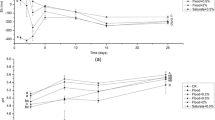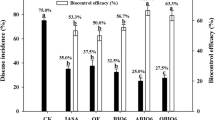Abstract
Banana Fusarium wilt caused by Fusarium oxysporum f. sp. cubense (FOC) is a worldwide soil-borne disease that causes serious economic losses every year. Effective ways of preventing the disease are still not available. In this study, biological soil disinfestation (BSD) with incorporation of various organic matters under flooding conditions combined with plastic mulching was applied to suppress FOC and prevent banana Fusarium wilt disease. The biological properties of the soil during the BSD process were investigated using quantitative real-time PCR and denaturing gradient gel electrophoresis. The results showed that the values of soil redox potential significantly decreased by >800 mV in the treatments that incorporated rice straw and bagasse under flooding conditions compared with untreated soil. The lowest soil pH (5.36) and a significant decline in the FOC population to 2.79 % of untreated soil were obtained in flooded soil with the highest amount of rice straw. Incorporation of bagasse, pig manure, and lime also significantly decreased the populations of FOC, but were less effective than rice straw. Application of rice straw under flooding conditions significantly increased soil bacterial diversity, and the increased bacteria were considered to have an antagonistic effect on FOC. In 2013 field experiment, a wilt disease control efficiency of 82.3 % was obtained in flooded soil incorporated with 0.5 % (w/w) rice straw compared with untreated soil, and the control efficiency of BSD was further confirmed in 2014 field experiment. These results indicated that BSD can reduce FOC populations in soil, ameliorate soil microbial communities, and reduce the occurrence of banana Fusarium wilt disease.








Similar content being viewed by others
References
Adesina, M. F., Lembke, A., Costa, R., Speksnijder, A., & Smalla, K. (2007). Screening of bacterial isolates from various European soils for in vitro antagonistic activity towards Rhizoctonia solani and Fusarium oxysporum: site-dependent composition and diversity revealed. Soil Biology & Biochemistry, 39, 2818–2828.
Blok, W. J., Lamers, J. G., Termorshuizen, A. J., & Bollen, G. J. (2000). Control of soilborne plant pathogens by incorporating fresh organic amendments followed by tarping. Phytopathology, 90, 253–259.
Butler, D. M., Rosskopf, E. N., Kokalis-Burelle, N., Albano, J. P., Muramoto, J., & Shennan, C. (2011). Exploring warm-season cover crops as carbon sources for anaerobic soil disinfestation (ASD). Plant and Soil, 355(1–2), 149–165.
Chinn, S. H. F., Sallans, B. J., & Ledingham, R. J. (1962). Spore populations of Helminthosporium sativum in soils in relation to the occurrence of common root rot of wheat. Canadian Journal of Plant Science, 4, 720–727.
Dita, M. A., Waalwijk, C., Buddenhagen, I. W., Souza, M. T., & Kema, G. H. J. (2010). A molecular diagnostic for tropical race 4 of the banana fusarium wilt pathogen. Plant Pathology, 59(2), 348–357.
Gamliel, A., Austerweil, M., & Kritzman, G. (2000). Non-chemical approach to soilborne pest management-organic amendments. Crop Protection, 19, 847–853.
Garbeva, P., Postma, J., Veen, J. A., & Elsas, J. D. (2006). Effect of above-ground plant species on soil microbial community structure and its impact on suppression of Rhizoctonia solani AG3. Environmental Microbiology, 8, 233–246.
Getha, K., & Vikineswary, S. (2002). Antagonistic effects of Streptomyces violaceusniger strain G10 on Fusarium oxysporum f. sp. cubense race 4: indirect evidence for the role of antibiosis in the antagonistic process. Journal of Industrial Microbiology & Biotechnology, 28, 303–310.
Goud, J. K. C., Termorshuizen, A. J., Blok, W. J., & van Bruggen, A. H. C. (2004). Long-term effect of biological soil disinfestation on Verticillium Wilt. Plant Disease, 88(7), 688–694.
Hu, P., Zhou, G., Xu, X., Li, C., & Han, Y. (2009). Characterization of the predominant spoilage bacteria in sliced vacuum-packed cooked ham based on 16S rDNA-DGGE. Food Control, 20, 99–104.
Huang, X., Chen, L., Ran, W., Shen, Q., & Yang, X. (2011). Trichoderma harzianum strain SQR-T37 and its bio-organic fertilizer could control Rhizoctonia solani damping-off disease in cucumber seedlings mainly by the mycoparasitism. Applied Microbiology and Biotechnology, 91(3), 741–755.
Katan, J. (1981). Solar heating (solarization) of soil for control of soil-borne pests. Annual Review of Phytopathology, 19, 211–236.
Katan, J. (2000). Physical and cultural methods for the management of soil-borne pathogens. Crop Protection, 19, 725–731.
Li, W. M., Qian, C. M., Mo, Y. W., Hu, Y. L., & Xie, J. H. (2011). Tolerance of banana for fusarium wilt is associated with early H2O2 accumulation in the roots. African Journal of Biotechnology, 10(55), 11378–11387.
Lin, Y., Su, C., Chao, C., Chen, C., Chang, C., Huang, J., & Chang, P. L. (2013). A molecular diagnosis method using real-time PCR for quantification and detection of Fusarium oxysporum f. sp. cubense race 4. European Journal of Plant Pathology, 135, 395–405.
López-Mondéjar, R., Antón, A., Raidl, S., Ros, M., & Pascual, J. A. (2010). Quantification of the biocontrol agent Trichoderma harzianum with real-time TaqMan PCR and its potential extrapolation to the hyphal biomass. Bioresource Technology, 101(8), 2888–2891.
Messiha, N. A. S., Diepeningen, A. D., Wenneker, M., Beuningen, A. R., Janse, J. D., Coenen, T. G. C., et al. (2007). Biological Soil Disinfestation (BSD), a new control method for potato brown rot, caused by Ralstonia solanacearum race 3 biovar 2. European Journal of Plant Pathology, 117(4), 403–415.
Minton, N. P., & Clarke, D. J. (1989). Biotechnology handbook vol. 3, Clostridia. New York: Plenum Press.
Minuto, A., Spadaro, D., Garibaldi, A., & Gullino, L. M. (2006). Control of soil borne pathogens of tomato using a commercial formulation of Streptomyces griseoviridis and solarization. Crop Protection, 15, 735–742.
Momma, N. (2008). Biological soil disinfestation (BSD) of soilborne pathogens and its possible mechanisms. Japan Agricultural Research Quarterly, 42(1), 7–12.
Momma, N., Usami, T., Amemiya, Y., & Shishido, M. (2005). Factors involved in the suppression of Fusarium oxysporum f. sp. lycopersici by soil reduction. Soil Microorganisms, 59(1), 27–33.
Momma, N., Yamamoto, K., Simandi, P., & Shishido, M. (2006). Role of organic acids in the mechanisms of biological soil disinfestation (BSD). Journal of General Plant Pathology, 72, 247–252.
Momma, N., Kobara, Y., Uematsu, S., Kita, N., & Shinmura, A. (2013). Development of biological soil disinfestations in Japan. Applied Microbiology and Biotechnology, 97, 3801–3809.
Mowlick, S., Inoue, T., Takehara, T., Kaku, N., Ueki, K., & Ueki, A. (2013). Changes and recovery of soil bacterial communities influenced by biological soil disinfestation as compared with chloropicrin-treatment. AMB Express, 3, 46–58.
Nübel, U., Engelen, B., Felske, A., Snaidr, J., Weishuber, A., Amman, R. I., et al. (1996). Sequence heterogeneities of genes encoding 16S rRNAs in Paenibacillus polymyxa detected by temperature gradient gel electrophoresis. Journal of Bacteriology, 178, 5636–5643.
Oka, Y., Shapira, N., & Fine, P. (2007). Control of root-knot nematodes in organic farming systems by organic amendments and soil solarization. Crop Protection, 26, 1556–1565.
PiedraBuena, A., García-Álvarez, A., Díez-Rojo, M. Á., & Bello, A. (2006). Use of crop residues for the control of Meloidogyne incognita under laboratory conditions. Pest Management Science, 62(10), 919–926.
Runia, W. T., & Molendijk, L. P. G. (2010). Physical methods for soil disinfestation in intensive agriculture: old methods and new approaches. Acta Horticulturae, 883, 249–258.
Shannon, C. E., & Weaver, W. (1963). The mathematical theory of communication. Urbana: University of Illinois Press.
Shinmura, A. (2000). Causal agent and control of root rot of welsh onion. PSJ Soilborne Disease Workshop Report, 20, 133–143.
Shinmura, A. (2004). Principle and effect of soil sterilization method by reducing redox potential of soil. PSJ Soilborne Disease Workshop Report, 22, 2–12.
Stover, R. H. (1962). Fusarial wilt (Panama disease) of bananas and other Musa species. Kew: Commonwealth Mycological Institute.
Stover, R. H. (1990). Fusarium wilt of banana: some history and current status of the disease. In R. C. Ploetz (Ed.), Fusarium Wilt of Banana (pp. 1–7). St Paul: American Phytopathological Scociety Press.
van den Berg, N., Berger, D. K., Hein, I., Birch, P. R. J., Wingfield, M. J., & Viljoen, A. (2007). Tolerance in banana to Fusarium wilt is associated with early up-regulation of cell wall-strengthening genes in the roots. Molecular Plant Pathology, 8, 333–341.
Weber, S., Stubner, S., & Conrad, R. (2001). Bacterial populations colonizing and degrading rice straw in anoxic paddy soil. Applied and Enviromental Microbiology, 67, 1318–1327.
Zoetendal, E. G., Akkermans, A. D., & de Vos, W. M. (1998). Temperature gradient gel electrophoresis analysis of 16S rRNA from human fecal samples reveals stable and host-specific communities of active bacteria. Applied and Enviromental Microbiology, 64, 3854–3859.
Acknowledgments
This study was financially supported by the National Natural Science Foundation of China (Grant Nos. 41301335, 41330744), the Specialized Research Fund for the Doctoral Program of Higher Education of China (20133207120018), China Postdoctoral Science Foundation (2014M551622), the Natural Science Foundation of Jiangsu Province (BK20140062), the Natural Science Foundation of the Jiangsu Higher Education Institutions of China (13KJA210002), Outstanding innovation team in Colleges and universities in Jiangsu Province and the Priority Academic Program Development of Jiangsu Higher Education Institutions (PAPD).
Author information
Authors and Affiliations
Corresponding author
Rights and permissions
About this article
Cite this article
Huang, X.Q., Wen, T., Zhang, J.B. et al. Control of soil-borne pathogen Fusarium oxysporum by biological soil disinfestation with incorporation of various organic matters. Eur J Plant Pathol 143, 223–235 (2015). https://doi.org/10.1007/s10658-015-0676-x
Accepted:
Published:
Issue Date:
DOI: https://doi.org/10.1007/s10658-015-0676-x




